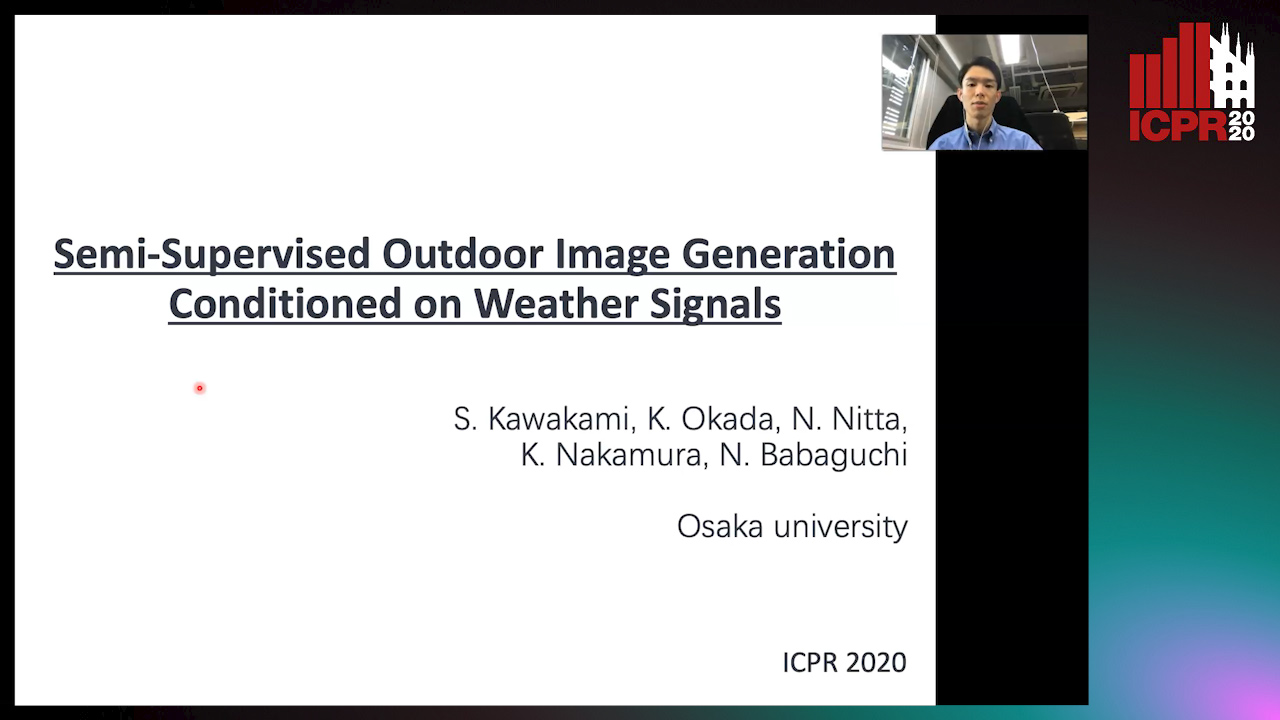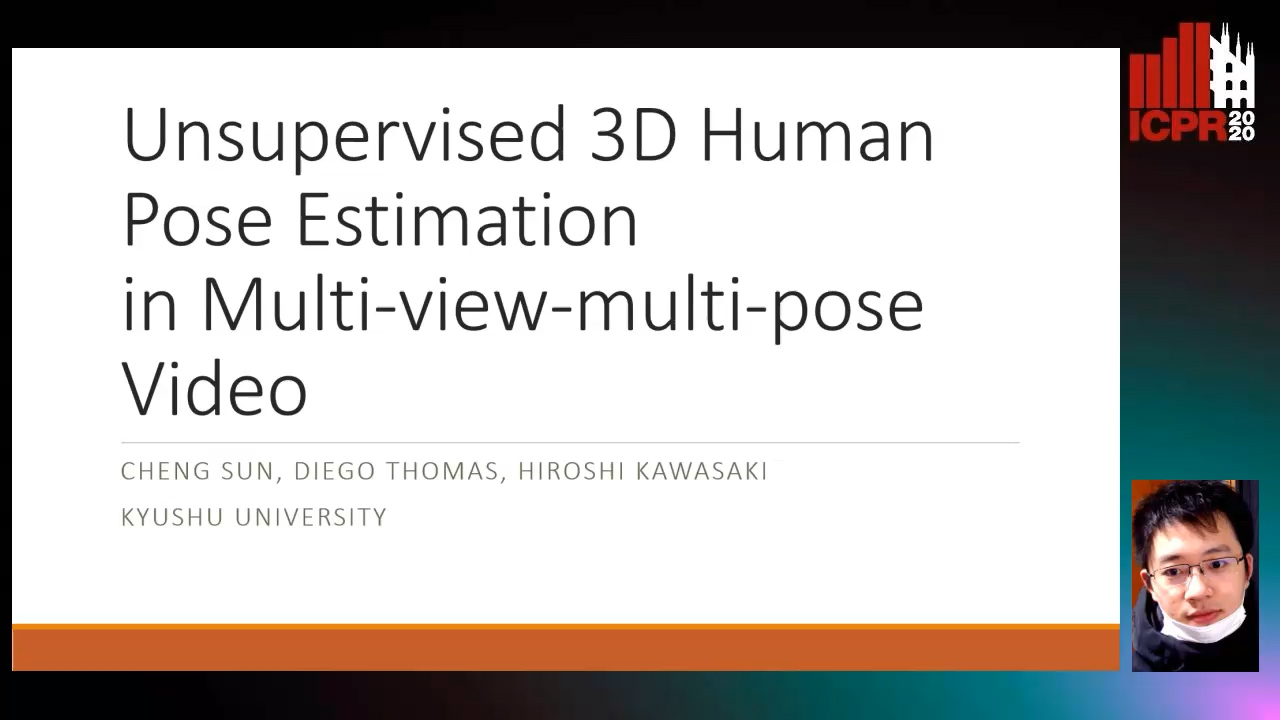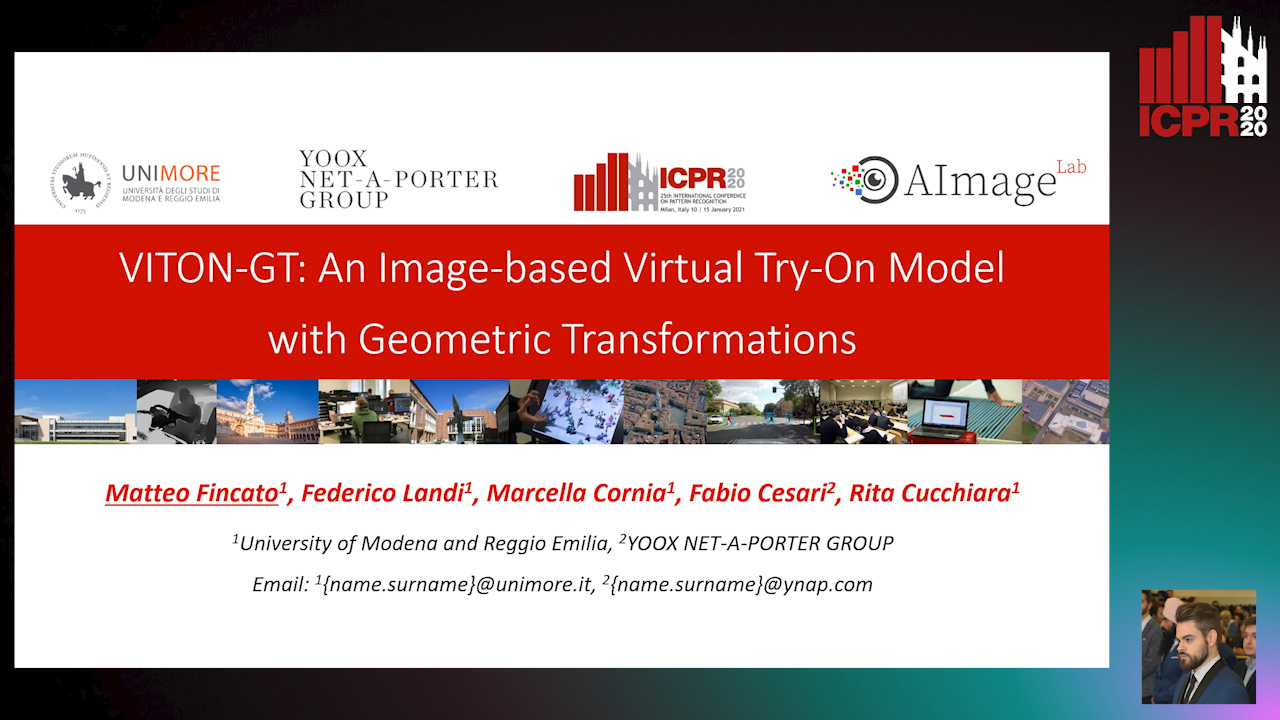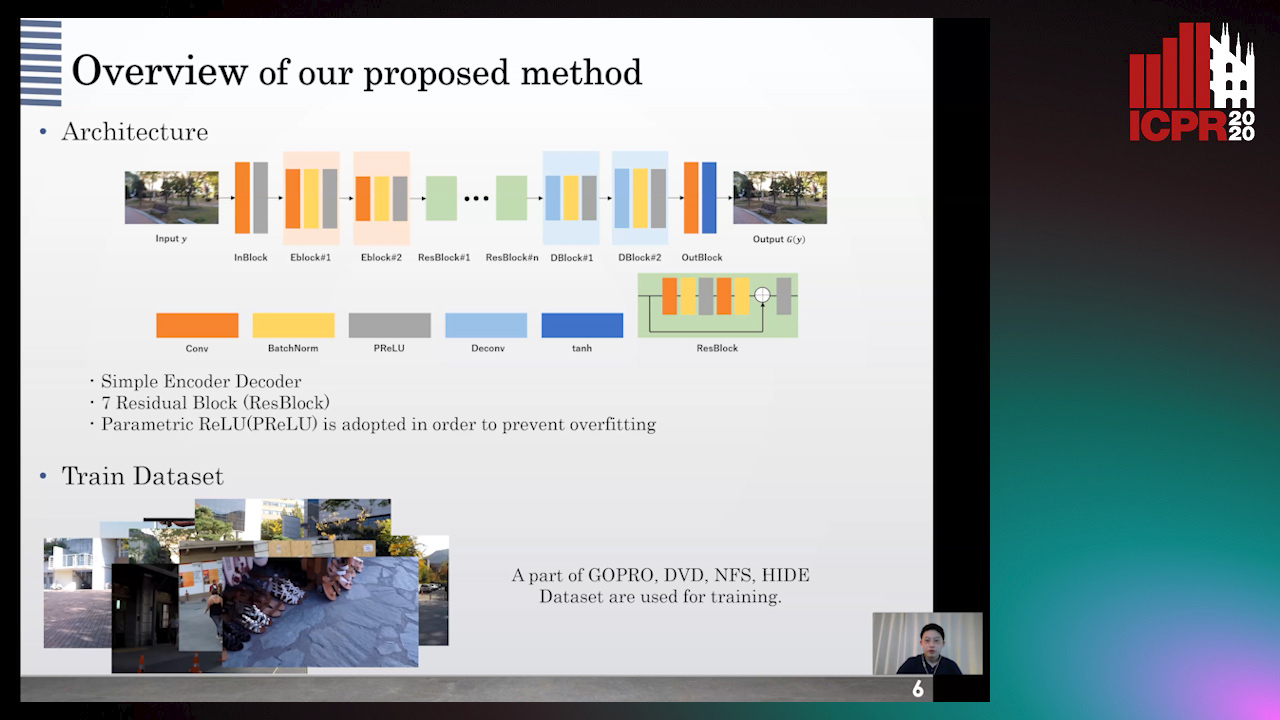Boundary Guided Image Translation for Pose Estimation from Ultra-Low Resolution Thermal Sensor
Kohei Kurihara,
Tianren Wang,
Teng Zhang,
Brian Carrington Lovell

Auto-TLDR; Pose Estimation on Low-Resolution Thermal Images Using Image-to-Image Translation Architecture
Similar papers
Thermal Image Enhancement Using Generative Adversarial Network for Pedestrian Detection
Mohamed Amine Marnissi, Hajer Fradi, Anis Sahbani, Najoua Essoukri Ben Amara

Auto-TLDR; Improving Visual Quality of Infrared Images for Pedestrian Detection Using Generative Adversarial Network
Abstract Slides Poster Similar
Detail Fusion GAN: High-Quality Translation for Unpaired Images with GAN-Based Data Augmentation
Ling Li, Yaochen Li, Chuan Wu, Hang Dong, Peilin Jiang, Fei Wang

Auto-TLDR; Data Augmentation with GAN-based Generative Adversarial Network
Abstract Slides Poster Similar
Robust Pedestrian Detection in Thermal Imagery Using Synthesized Images
My Kieu, Lorenzo Berlincioni, Leonardo Galteri, Marco Bertini, Andrew Bagdanov, Alberto Del Bimbo

Auto-TLDR; Improving Pedestrian Detection in the thermal domain using Generative Adversarial Network
Abstract Slides Poster Similar
Multi-Laplacian GAN with Edge Enhancement for Face Super Resolution

Auto-TLDR; Face Image Super-Resolution with Enhanced Edge Information
Abstract Slides Poster Similar
Local Facial Attribute Transfer through Inpainting
Ricard Durall, Franz-Josef Pfreundt, Janis Keuper

Auto-TLDR; Attribute Transfer Inpainting Generative Adversarial Network
Abstract Slides Poster Similar
Stylized-Colorization for Line Arts
Tzu-Ting Fang, Minh Duc Vo, Akihiro Sugimoto, Shang-Hong Lai

Auto-TLDR; Stylized-colorization using GAN-based End-to-End Model for Anime
Abstract Slides Poster Similar
SIDGAN: Single Image Dehazing without Paired Supervision
Pan Wei, Xin Wang, Lei Wang, Ji Xiang, Zihan Wang

Auto-TLDR; DehazeGAN: An End-to-End Generative Adversarial Network for Image Dehazing
Abstract Slides Poster Similar
Exemplar Guided Cross-Spectral Face Hallucination Via Mutual Information Disentanglement
Haoxue Wu, Huaibo Huang, Aijing Yu, Jie Cao, Zhen Lei, Ran He

Auto-TLDR; Exemplar Guided Cross-Spectral Face Hallucination with Structural Representation Learning
Abstract Slides Poster Similar
Unsupervised Face Manipulation Via Hallucination
Keerthy Kusumam, Enrique Sanchez, Georgios Tzimiropoulos

Auto-TLDR; Unpaired Face Image Manipulation using Autoencoders
Abstract Slides Poster Similar
GarmentGAN: Photo-Realistic Adversarial Fashion Transfer
Amir Hossein Raffiee, Michael Sollami

Auto-TLDR; GarmentGAN: A Generative Adversarial Network for Image-Based Garment Transfer
Abstract Slides Poster Similar
Cycle-Consistent Adversarial Networks and Fast Adaptive Bi-Dimensional Empirical Mode Decomposition for Style Transfer
Elissavet Batziou, Petros Alvanitopoulos, Konstantinos Ioannidis, Ioannis Patras, Stefanos Vrochidis, Ioannis Kompatsiaris

Auto-TLDR; FABEMD: Fast and Adaptive Bidimensional Empirical Mode Decomposition for Style Transfer on Images
Abstract Slides Poster Similar
Small Object Detection Leveraging on Simultaneous Super-Resolution
Hong Ji, Zhi Gao, Xiaodong Liu, Tiancan Mei

Auto-TLDR; Super-Resolution via Generative Adversarial Network for Small Object Detection
Future Urban Scenes Generation through Vehicles Synthesis
Alessandro Simoni, Luca Bergamini, Andrea Palazzi, Simone Calderara, Rita Cucchiara

Auto-TLDR; Predicting the Future of an Urban Scene with a Novel View Synthesis Paradigm
Abstract Slides Poster Similar
Super-Resolution Guided Pore Detection for Fingerprint Recognition
Syeda Nyma Ferdous, Ali Dabouei, Jeremy Dawson, Nasser M. Nasarabadi

Auto-TLDR; Super-Resolution Generative Adversarial Network for Fingerprint Recognition Using Pore Features
Abstract Slides Poster Similar
High Resolution Face Age Editing
Xu Yao, Gilles Puy, Alasdair Newson, Yann Gousseau, Pierre Hellier

Auto-TLDR; An Encoder-Decoder Architecture for Face Age editing on High Resolution Images
Abstract Slides Poster Similar
Galaxy Image Translation with Semi-Supervised Noise-Reconstructed Generative Adversarial Networks
Qiufan Lin, Dominique Fouchez, Jérôme Pasquet

Auto-TLDR; Semi-supervised Image Translation with Generative Adversarial Networks Using Paired and Unpaired Images
Abstract Slides Poster Similar
Cascade Attention Guided Residue Learning GAN for Cross-Modal Translation
Bin Duan, Wei Wang, Hao Tang, Hugo Latapie, Yan Yan

Auto-TLDR; Cascade Attention-Guided Residue GAN for Cross-modal Audio-Visual Learning
Abstract Slides Poster Similar
Towards Artifacts-Free Image Defogging
Gabriele Graffieti, Davide Maltoni

Auto-TLDR; CurL-Defog: Learning Based Defogging with CycleGAN and HArD
A NoGAN Approach for Image and Video Restoration and Compression Artifact Removal
Mameli Filippo, Marco Bertini, Leonardo Galteri, Alberto Del Bimbo

Auto-TLDR; Deep Neural Network for Image and Video Compression Artifact Removal and Restoration
Pose Variation Adaptation for Person Re-Identification
Lei Zhang, Na Jiang, Qishuai Diao, Yue Xu, Zhong Zhou, Wei Wu

Auto-TLDR; Pose Transfer Generative Adversarial Network for Person Re-identification
Abstract Slides Poster Similar
Continuous Learning of Face Attribute Synthesis
Ning Xin, Shaohui Xu, Fangzhe Nan, Xiaoli Dong, Weijun Li, Yuanzhou Yao

Auto-TLDR; Continuous Learning for Face Attribute Synthesis
Abstract Slides Poster Similar
Multi-Domain Image-To-Image Translation with Adaptive Inference Graph
The Phuc Nguyen, Stéphane Lathuiliere, Elisa Ricci

Auto-TLDR; Adaptive Graph Structure for Multi-Domain Image-to-Image Translation
Abstract Slides Poster Similar
The Role of Cycle Consistency for Generating Better Human Action Videos from a Single Frame

Auto-TLDR; Generating Videos with Human Action Semantics using Cycle Constraints
Abstract Slides Poster Similar
Learning Disentangled Representations for Identity Preserving Surveillance Face Camouflage
Jingzhi Li, Lutong Han, Hua Zhang, Xiaoguang Han, Jingguo Ge, Xiaochu Cao

Auto-TLDR; Individual Face Privacy under Surveillance Scenario with Multi-task Loss Function
Boosting High-Level Vision with Joint Compression Artifacts Reduction and Super-Resolution
Xiaoyu Xiang, Qian Lin, Jan Allebach

Auto-TLDR; A Context-Aware Joint CAR and SR Neural Network for High-Resolution Text Recognition and Face Detection
Abstract Slides Poster Similar
Semi-Supervised Outdoor Image Generation Conditioned on Weather Signals
Sota Kawakami, Kei Okada, Naoko Nitta, Kazuaki Nakamura, Noboru Babaguchi

Auto-TLDR; Semi-supervised Generative Adversarial Network for Prediction of Weather Signals from Outdoor Images
Abstract Slides Poster Similar
Dual-MTGAN: Stochastic and Deterministic Motion Transfer for Image-To-Video Synthesis
Fu-En Yang, Jing-Cheng Chang, Yuan-Hao Lee, Yu-Chiang Frank Wang

Auto-TLDR; Dual Motion Transfer GAN for Convolutional Neural Networks
Abstract Slides Poster Similar
Unsupervised 3D Human Pose Estimation in Multi-view-multi-pose Video
Cheng Sun, Diego Thomas, Hiroshi Kawasaki

Auto-TLDR; Unsupervised 3D Human Pose Estimation from 2D Videos Using Generative Adversarial Network
Abstract Slides Poster Similar
Attributes Aware Face Generation with Generative Adversarial Networks
Zheng Yuan, Jie Zhang, Shiguang Shan, Xilin Chen

Auto-TLDR; AFGAN: A Generative Adversarial Network for Attributes Aware Face Image Generation
Abstract Slides Poster Similar
VITON-GT: An Image-Based Virtual Try-On Model with Geometric Transformations
Matteo Fincato, Federico Landi, Marcella Cornia, Fabio Cesari, Rita Cucchiara

Auto-TLDR; VITON-GT: An Image-based Virtual Try-on Architecture for Fashion Catalogs
Abstract Slides Poster Similar
On-Device Text Image Super Resolution
Dhruval Jain, Arun Prabhu, Gopi Ramena, Manoj Goyal, Debi Mohanty, Naresh Purre, Sukumar Moharana

Auto-TLDR; A Novel Deep Neural Network for Super-Resolution on Low Resolution Text Images
Abstract Slides Poster Similar
DEN: Disentangling and Exchanging Network for Depth Completion
You-Feng Wu, Vu-Hoang Tran, Ting-Wei Chang, Wei-Chen Chiu, Ching-Chun Huang

Auto-TLDR; Disentangling and Exchanging Network for Depth Completion
UDBNET: Unsupervised Document Binarization Network Via Adversarial Game
Amandeep Kumar, Shuvozit Ghose, Pinaki Nath Chowdhury, Partha Pratim Roy, Umapada Pal

Auto-TLDR; Three-player Min-max Adversarial Game for Unsupervised Document Binarization
Abstract Slides Poster Similar
Tarsier: Evolving Noise Injection inSuper-Resolution GANs
Baptiste Roziere, Nathanaël Carraz Rakotonirina, Vlad Hosu, Rasoanaivo Andry, Hanhe Lin, Camille Couprie, Olivier Teytaud

Auto-TLDR; Evolutionary Super-Resolution using Diagonal CMA
Abstract Slides Poster Similar
UCCTGAN: Unsupervised Clothing Color Transformation Generative Adversarial Network
Shuming Sun, Xiaoqiang Li, Jide Li

Auto-TLDR; An Unsupervised Clothing Color Transformation Generative Adversarial Network
Abstract Slides Poster Similar
Mask-Based Style-Controlled Image Synthesis Using a Mask Style Encoder
Jaehyeong Cho, Wataru Shimoda, Keiji Yanai

Auto-TLDR; Style-controlled Image Synthesis from Semantic Segmentation masks using GANs
Abstract Slides Poster Similar
Residual Fractal Network for Single Image Super Resolution by Widening and Deepening
Jiahang Gu, Zhaowei Qu, Xiaoru Wang, Jiawang Dan, Junwei Sun

Auto-TLDR; Residual fractal convolutional network for single image super-resolution
Abstract Slides Poster Similar
MBD-GAN: Model-Based Image Deblurring with a Generative Adversarial Network

Auto-TLDR; Model-Based Deblurring GAN for Inverse Imaging
Abstract Slides Poster Similar
Progressive Splitting and Upscaling Structure for Super-Resolution

Auto-TLDR; PSUS: Progressive and Upscaling Layer for Single Image Super-Resolution
Abstract Slides Poster Similar
Semantic-Guided Inpainting Network for Complex Urban Scenes Manipulation
Pierfrancesco Ardino, Yahui Liu, Elisa Ricci, Bruno Lepri, Marco De Nadai

Auto-TLDR; Semantic-Guided Inpainting of Complex Urban Scene Using Semantic Segmentation and Generation
Abstract Slides Poster Similar
GAN-Based Image Deblurring Using DCT Discriminator
Hiroki Tomosada, Takahiro Kudo, Takanori Fujisawa, Masaaki Ikehara

Auto-TLDR; DeblurDCTGAN: A Discrete Cosine Transform for Image Deblurring
Abstract Slides Poster Similar
LiNet: A Lightweight Network for Image Super Resolution
Armin Mehri, Parichehr Behjati Ardakani, Angel D. Sappa

Auto-TLDR; LiNet: A Compact Dense Network for Lightweight Super Resolution
Abstract Slides Poster Similar
Let's Play Music: Audio-Driven Performance Video Generation
Hao Zhu, Yi Li, Feixia Zhu, Aihua Zheng, Ran He

Auto-TLDR; APVG: Audio-driven Performance Video Generation Using Structured Temporal UNet
Abstract Slides Poster Similar
Deep Photo Relighting by Integrating Both 2D and 3D Lighting Information
Takashi Machida, Satoru Nakanishi

Auto-TLDR; DPR: Deep Photorelighting for Image Detection/Classification and Data Augmentation
Abstract Slides Poster Similar
Adaptive Image Compression Using GAN Based Semantic-Perceptual Residual Compensation
Ruojing Wang, Zitang Sun, Sei-Ichiro Kamata, Weili Chen

Auto-TLDR; Adaptive Image Compression using GAN based Semantic-Perceptual Residual Compensation
Abstract Slides Poster Similar
RGB-Infrared Person Re-Identification Via Image Modality Conversion
Huangpeng Dai, Qing Xie, Yanchun Ma, Yongjian Liu, Shengwu Xiong

Auto-TLDR; CE2L: A Novel Network for Cross-Modality Re-identification with Feature Alignment
Abstract Slides Poster Similar
Shape Consistent 2D Keypoint Estimation under Domain Shift
Levi Vasconcelos, Massimiliano Mancini, Davide Boscaini, Barbara Caputo, Elisa Ricci

Auto-TLDR; Deep Adaptation for Keypoint Prediction under Domain Shift
Abstract Slides Poster Similar
Face Super-Resolution Network with Incremental Enhancement of Facial Parsing Information
Shuang Liu, Chengyi Xiong, Zhirong Gao

Auto-TLDR; Learning-based Face Super-Resolution with Incremental Boosting Facial Parsing Information
Abstract Slides Poster Similar